
A bunion, also known as hallux valgus, is a bony bump that forms at the base of the big toe. It occurs when the big toe moves toward the second toe, causing the joint to protrude and become misaligned. This misalignment can lead to pain, swelling, and redness around the affected area, making it difficult to wear certain shoes. Bunion formation is often gradual, and the condition can worsen over time without treatment. There are several risk factors that increase the likelihood of developing a bunion, including a family history of the condition, wearing tight or ill-fitting shoes, and certain foot deformities. Additionally, women are more prone to bunions than men, likely due to the frequent wearing of high heels. Bunions can also develop as a result of arthritis or other medical conditions that affect the joints. If left untreated, bunions can cause difficulty walking and further joint damage.If you have any of the above symptoms, it is suggested that you consult a podiatrist who can accurately diagnose and offer effective treatment solutions for bunions.
If you are suffering from bunions, contact one of our podiatrists of Mercer Ocean Podiatry. Our doctor can provide the care you need to keep you pain-free and on your feet.
What Is a Bunion?
A bunion is formed of swollen tissue or an enlargement of boney growth, usually located at the base joint of the toe that connects to the foot. The swelling occurs due to the bones in the big toe shifting inward, which impacts the other toes of the foot. This causes the area around the base of the big toe to become inflamed and painful.
Why Do Bunions Form?
Genetics – Susceptibility to bunions are often hereditary
Stress on the feet – Poorly fitted and uncomfortable footwear that places stress on feet, such as heels, can worsen existing bunions
How Are Bunions Diagnosed?
Doctors often perform two tests – blood tests and x-rays – when trying to diagnose bunions, especially in the early stages of development. Blood tests help determine if the foot pain is being caused by something else, such as arthritis, while x-rays provide a clear picture of your bone structure to your doctor.
How Are Bunions Treated?
- Refrain from wearing heels or similar shoes that cause discomfort
- Select wider shoes that can provide more comfort and reduce pain
- Anti-inflammatory and pain management drugs
- Orthotics or foot inserts
- Surgery
If you have any questions, please feel free to contact our office located in Toms River, NJ . We offer the newest diagnostic and treatment technologies for all your foot care needs.
